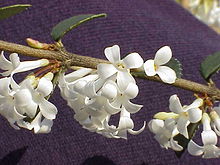Osmanthus delavayi
| Osmanthus delavayi | ||||||||||||
|---|---|---|---|---|---|---|---|---|---|---|---|---|

Osmanthus delavayi |
||||||||||||
| Systematics | ||||||||||||
|
||||||||||||
| Scientific name | ||||||||||||
| Osmanthus delavayi | ||||||||||||
| Franch. |
Osmanthus delavayi is a type of plant from the genus of the scented flowers ( Osmanthus ) within the olive family (Oleaceae). It comes from south-central China and is used as an ornamental wood .
description
Vegetative characteristics
Osmanthus delavayi grows as an evergreen shrub and reaches heights of up to 2, rarely up to 5 meters. The bark of the branches is downy and hairy. The crown is wide; older specimens are about as wide as they are tall. Osmanthus delavayi grows slowly and can reach a relatively old age.
The constantly against arranged on the branches leaves are divided into petiole and leaf blade. The petiole has a length of 0.8 to 1 cm. The leathery leaf blade is elliptical to elliptical-lanceolate in shape with a length of 5 to 9 cm and a width of 2.6 to 3.5 cm . The leaf surfaces are glossy green to dark green. The leaf margin is usually finely serrated.
Generative characteristics
The flowering period extends from late winter to spring. In the leaf axils there are often some zymose inflorescences that contain many flowers. The bracts are broadly ovate with a length of 2 to 4 mm. The slightly glandular hairy pedicel has a length of 7 to 12 mm.
The mostly hermaphrodite flowers exude an intense, sweet fragrance and are four-fold with a double flower envelope . The cup is only about 2 mm in size. The yellowish, white to yellow, 10 to 15 mm long petals are fused into a tube up to 10 mm long. The stamens are fused with the center of the corolla tube.
With a length of 1 to 1.5 cm across ellipsoid drupes turn blue when ripe in March to purple-black.
Occurrence
Osmanthus delavayi occurs in the Chinese provinces of Guizhou, Sichuan and Yunnan. Osmanthus delavayi thrives in mountain regions, ravines, in thickets and in mixed forests at altitudes of 2100 to 3400 meters.
Taxonomy and Botanical History
The first description of Osmanthus delavayi was in 1886 by Adrien René Franchet in Bulletin Mensuel de la Société Linnéenne de Paris , 1, 77, pp. 613-614. Synonyms for Osmanthus delavayi Franch. are: Ligustrum phillyrea H.Lév. , Siphonosmanthus delavayi (Franch.) Stapf .
Osmanthus delavayi was discovered in 1890 by the Jesuit Pierre Jean Marie Delavay in the mountain region of Lan kong at an altitude of 2800 meters in the Chinese province of Yunnan . He sent seeds to the French breeder Maurice de Vilmorin . Although Vilmorin also distributed the seeds to several correspondents, only one could be germinated. All Osmanthus delavayi in European gardens were cloned from this specimen until George Forrest brought more seeds from China after the First World War .
use
Because of its fragrant flowers, Osmanthus delavayi is used as an ornamental plant in parks and gardens in climatically favorable areas . It doesn't smell as strong as Osmanthus fragrans , but the flowers are a lot larger. Osmanthus delavayi won an Award of Garden Merit from the Royal Horticultural Society in 1923 . It is used, for example, as an ornamental shrub on the east coast from Australia to Tasmania . Its USDA zone is in the range between 7 and 9 (withstands temperatures down to −15 ° C).
Common names
In China, a common name is Chinese 山 , Pinyin shān guì huā , translated as mountain cinnamon blossom.
swell
- Mei-chen Chang, Lien-ching Chiu, Zhi Wei, Peter S. Green: Oleaceae. : Osmanthus delavayi , p. 289 - the same text online as the printed work , In: Wu Zheng-yi & Peter H. Raven (eds.): Flora of China , Volume 15 - Myrsinaceae through Loganiaceae , Science Press and Missouri Botanical Garden Press, Beijing and St. Louis, 1996, ISBN 0-915279-37-1 . (Sections Description and Distribution)
Individual evidence
- ↑ a b c Rafaël Govaerts (Ed.): Osmanthus delavayi. In: World Checklist of Selected Plant Families (WCSP) - The Board of Trustees of the Royal Botanic Gardens, Kew . Retrieved March 20, 2016.
- ↑ a b c d Mei-chen Chang, Lien-ching Chiu, Zhi Wei, Peter S. Green: Oleaceae. : Osmanthus delavayi , p. 289 - the same text online as the printed work , In: Wu Zheng-yi, Peter H. Raven (Ed.): Flora of China , Volume 15 - Myrsinaceae through Loganiaceae , Science Press and Missouri Botanical Garden Press, Beijing and St. Louis, 1996, ISBN 0-915279-37-1 .
- ^ A b Adrien René Franchet: Bulletin Mensuel de la Société Linnéenne de Paris , 1, 77, 1886, pp. 613–614. Osmanthus delavayi scanned at biodiversitylibrary.org
- ↑ Alice M. Coats: Garden Shrubs and Their Histories (1964) 1992, "Osmanthus".
- ↑ Don Burke: The Complete Burke's Backyard: the ultimate book of fact sheets , "Osmanthus delavayi" .

